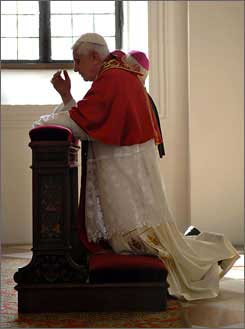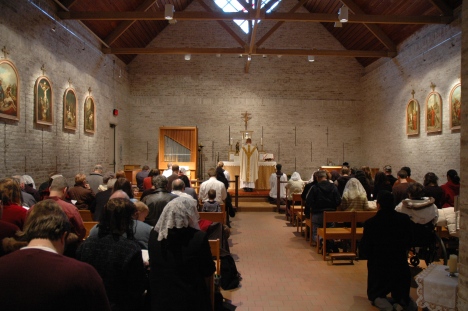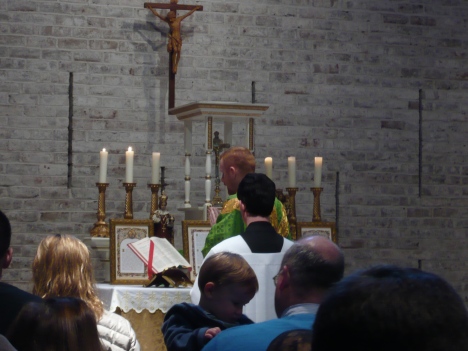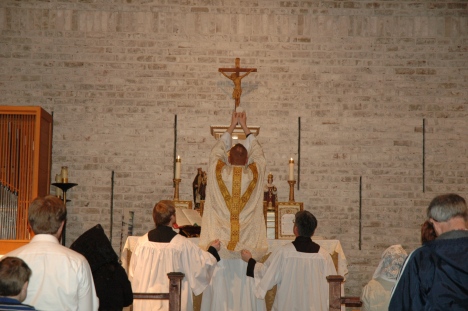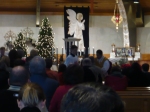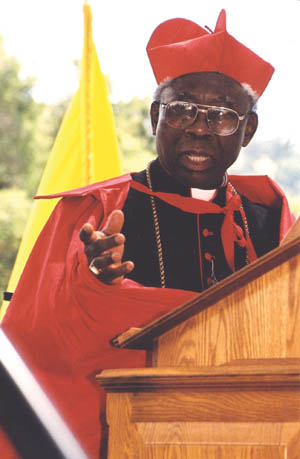
1. Advantages of Latin in the Roman Liturgy
As was mentioned above, by the fourth century, Latin had replaced Greek as the official language of the Church of Rome. Prominent among the Latin Fathers of the Church who wrote extensively and beautifully in Latin were St Ambrose (339-397), St Augustine of Hippo (354-430), St Leo the Great († 461) and Pope Gregory the Great (540-604). Pope Gregory, in particular, brought Latin to a great height in the sacred liturgy, in his sermons and in general Church use.
The Roman Rite Church showed extraordinary missionary dynamism. This explains why a greater part of the world has been evangelized by heralds of the Latin Rite. Many European languages which we regard as modern today have roots in Latin, some more than others. Examples are Italian, Spanish, Romanian, Portuguese and French. But even English and German do borrow from Latin.
The Popes and the Roman Church have found Latin very suitable for many reasons. It fits a Church which is universal, a Church in which all peoples, languages and cultures should feel at home and no one is regarded as a stranger.
Moreover, the Latin language has a certain stability which daily spoken languages, where words change often in shades of meaning, cannot have. An example is the translation of the Latin “propagare”. The Congregation for the Evangelization of Peoples when it was founded in 1627 was called “Sacra Congregatio de Propaganda Fide”. But at the time of the Second Vatican Council many modern languages use the word “propaganda” in the sense in which we say “political propaganda”. Therefore, there is a preference in the Church today to avoid the expression “de propaganda Fide”, in favour of “the Evangelization of Peoples”.
Latin has the characteristic of words and expressions retaining their meaning generation after generation. This is an advantage when it comes to the articulation of our Catholic faith and the preparation of Papal and other Church Documents. Even the modern universities appreciate this point and have some of their solemn titles in Latin.
Blessed Pope John XXIII in his Apostolic Constitution, Veterum Sapientia, issued on 22 February 1962, gives these two reasons and adds a third. The Latin language has a nobility and dignity which are not negligible (cf. Veterum Sapientia, nn. 5, 6, 7). We can add that Latin is concise, precise and poetically measured.
Is it not admirable that people, especially well-trained clerics, can meet in international gatherings and be able to communicate at least in Latin? More importantly, is it a small matter that 1 million young people could meet in the World Youth Day Convention in Rome in 2000, in Toronto in 2002 and in Cologne in 2005, and be able to sing parts of the Mass, and especially the Credo, in Latin? Theologians can study the original writings of the early Latin Fathers and of the Scholastics without tears because these were written in Latin.
It is true that there is a tendency, both in the Church and in the world at large, to give more attention today to modern languages, like English, French and Spanish, which can help one secure a job quicker in the modern employment market or in the Ministry of Foreign Affairs in their country.
But the exhortation of Pope Benedict XVI to the students of the Faculty of Christian and Classical Letters of the Pontifical Salesian University of Rome, at the end of the Wednesday General Audience of 22 February 2006, retains its validity and relevance. And he pronounced it in Latin! Here is my free English translation: “Quite rightly our Predecessors have urged the study of the great Latin language so that one may learn better the saving doctrine that is found in ecclesiastical and humanistic disciplines. In the same way we urge you to cultivate this activity so that as many as possible may have access to this treasure and appreciate its importance” (in L’Osservatore Romano, 45, 23 February 2006, p. 5).
2. Gregorian Chant
“Liturgical action is given a more noble form when sacred rites are solemnized in song” (SC, n. 113). There is an ancient saying: bis orat qui bene cantat, that is, “the person who sings well prays twice”. This is so because the intensity that prayer acquires from being sung, increases its ardour and multiplies its efficacy (cf. Paul VI: Address to Italian Schola Cantorum, 25 September 1977, in Notitiae 136, November 1977, p. 475).
Good music helps to promote prayer, to raise the minds of people to God and to give people a taste of the goodness of God.
In the Latin Rite what has come to be known as the Gregorian Chant has been traditional. A distinctive liturgical chant existed indeed in Rome before St Gregory the Great (+604). But it was this great Pontiff who gave it the greatest prominence.
After St Gregory this tradition of chant continued to develop and be enriched until the upheavals that brought an end to the Middle Ages. The monasteries, especially those of the Benedictine Order, have done much to preserve this heritage.
Gregorian Chant is marked by a moving meditative cadence. It touches the depths of the soul. It shows joy, sorrow, repentance, petition, hope, praise or thanksgiving, as the particular feast, part of the Mass or other prayer may indicate. It makes the Psalms come alive. It has a universal appeal which makes it suitable for all cultures and peoples. It is appreciated in Rome, Solesmes, Lagos, Toronto and Caracas. Cathedrals, monasteries, seminaries, sanctuaries, pilgrimage centres and traditional parishes resound with it.
St Pope Pius X extolled the Gregorian Chant in 1904 (cf. Tra le Sollecitudini, n. 3). The Second Vatican Council praised it in 1963: “The Church acknowledges Gregorian Chant as proper to the Roman liturgy: therefore, other things being equal, it should be given pride of place in liturgical services” (SC, n. 116).
The Servant of God, Pope John Paul II, repeated this praise in 2003 (cf. Chirograph for the Centenary of Tra Le Sollecitudini, nn. 4-7; in Congregation for Divine Worship and the Discipline of the Sacraments: Spiritus et Sponsa, 2003, p. 130).
Pope Benedict XVI encouraged the International Association of Pueri Cantores when they met in Rome at the end of 2005. They give a privileged place to the Gregorian Chant. In Rome and throughout the world the Church is blessed with many fine choirs, both professional and amateur, that render the chant beautifully, and communicate their enthusiasm for it.
It is not true that the lay faithful do not want to sing the Gregorian Chant. What they are asking for are priests and monks and nuns who will share this treasure with them.
The CDs produced by the Benedictine monks of Silos, their motherhouse at Solesmes, and numerous other communities sell among young people. Monasteries are visited by people who want to sing Lauds and especially Vespers.
In an ordination ceremony of 11 priests which I celebrated in Nigeria last July, about 150 priests sang the First Eucharistic Prayer in Latin. It was beautiful. The people, although no Latin scholars, loved it. It should be just normal that parish churches where there are four or five Masses on Sunday should have one of these Masses sung in Latin.
3. Did Vatican II discourage Latin?
Some people think, or have the perception, that the Second Vatican Council discouraged the use of Latin in the liturgy. This is not the case.
Just before he opened the Council, Bl. Pope John XXIII in 1962 issued an Apostolic Constitution to insist on the use of Latin in the Church. The Second Vatican Council, although it admitted some introduction of the vernacular, insisted on the place of Latin: “Particular law remaining in force, the use of the Latin language is to be preserved in the Latin rites” (SC, n. 36).
The Council also required that seminarians “should acquire a command of Latin which will enable them to understand and use the source material of so many sciences and the documents of the Church as well” (Optatam Totius, n. 13). The Code of Canon Law published in 1983 enacts that “the Eucharistic celebration is to be carried out either in the Latin language or in another language, provided the liturgical texts have been lawfully approved” (can. 928).
Those, therefore, who want to give the impression that the Church has put Latin away from her liturgy are mistaken. A manifestation of people’s acceptance of Latin liturgy well celebrated was had at the world level in April 2005, when millions followed the burial rites of Pope John Paul II and then, two weeks later, the inauguration Mass of Pope Benedict XVI over the television. It is remarkable that young people welcome the Mass celebrated in Latin.
Filed under: Uncategorized | Tagged: bible, big questions, Bishop William A. Higi, Bishop William Leo Higi, blogs, cardinal, Carmel, Carmel Indiana, Catholic, Christ, Christ Our Hope, Christian, Christianity, church, current events, Diocese of Lafayette in Indiana, faith, Father, Father McMann, Father Roberts, francis arinz, FSSP, God, hilary, history, Holy Rosary, IN, Indianapolis, Inspiration, Jesus, King, last supper, Latin Mass Surges, laura ingraham, Local News, MotuProprio, news, Obama, Our lady of Mount Carmel, Our Lady of Mt. Carmel, Padre Pio, Pope Benedict XVI, pope mobile, ramblings, religion, Retreats, sacred architecture, Souls, spirituality, SSPX, St. Elizabeth Seton Carmel Indiana, St. John Bosco Latin Mass Community, Star, Summorum Pontificum, the last supper, TLM, Traditional Latin Mass, Truth, Una Voce America, Una Voce Carmel, Uncategorized announcements, William Leo Higi | Leave a comment »


